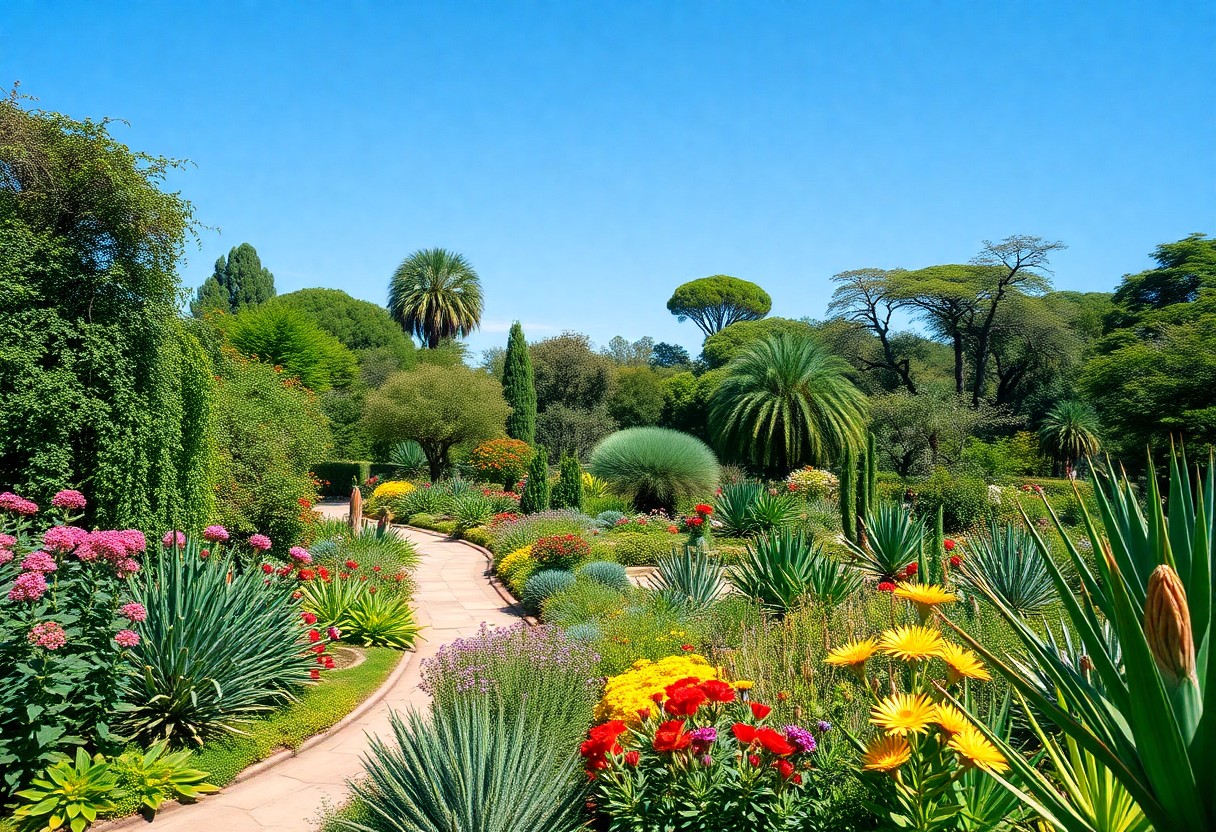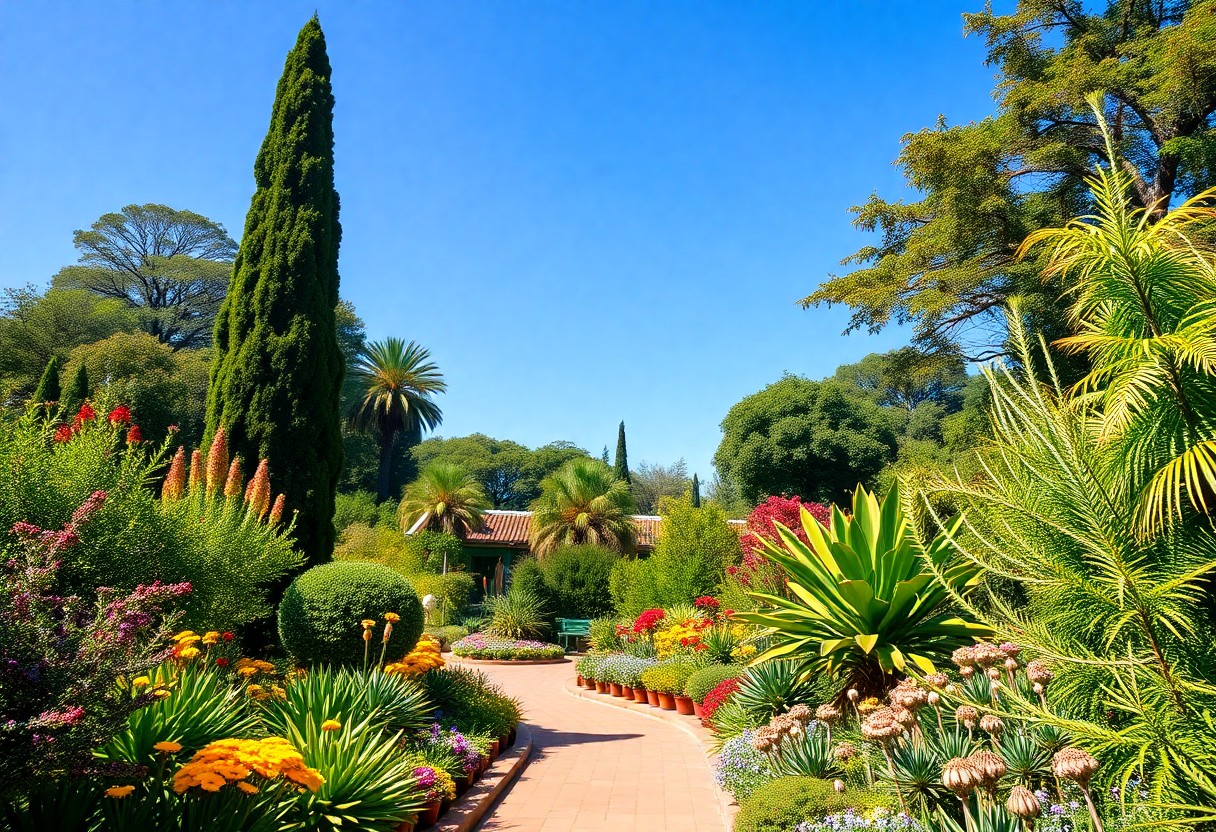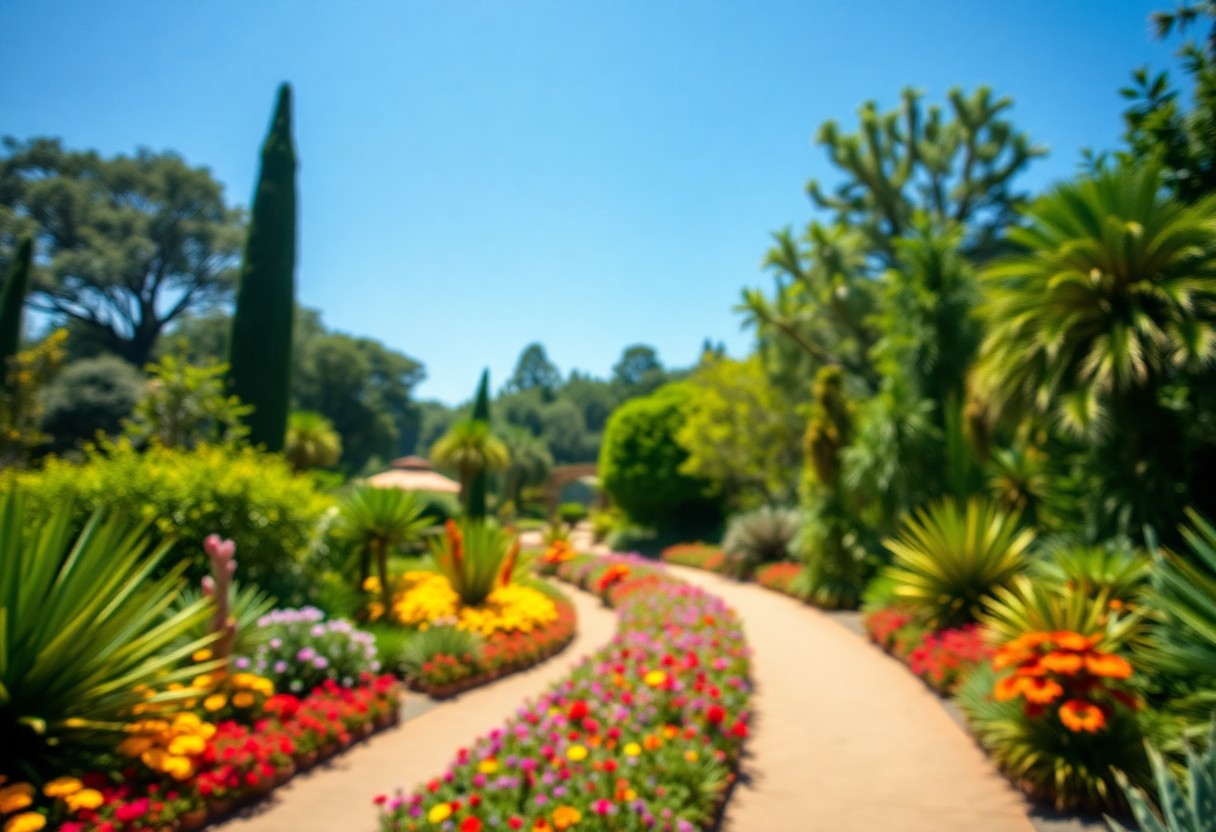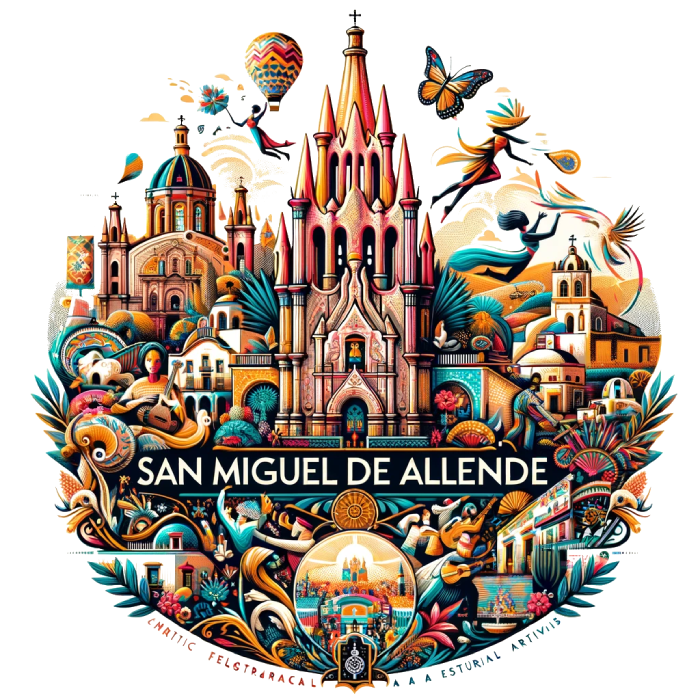Botanically rich and breathtaking, San Miguel de Allende’s hidden gardens offer a spectacular escape from the city’s bustling streets. Nestled in the heart of Mexico’s central highlands, these gardens provide an extraordinary botanical experience that reveals the region’s diverse plant life. You’ll discover a tranquil sanctuary where native and exotic species thrive, showcasing the area’s remarkable biodiversity. Whether you’re a passionate plant enthusiast or simply seeking a peaceful retreat, these gardens offer an immersive journey through stunning landscapes that highlight San Miguel de Allende’s natural beauty and ecological significance.

Overview of San Miguel de Allende
Your journey through San Miguel de Allende reveals a captivating destination in Mexico’s central highlands. This enchanting city offers a unique blend of colonial architecture, artistic vibrancy, and natural beauty that instantly charms you. San Miguel de Allende is a UNESCO World Heritage Site, attracting travelers with its vibrant culture, historic streets, and remarkable botanical gardens showcasing the region’s extraordinary biodiversity.
Historical Significance
By the mid-16th century, San Miguel emerged as a pivotal location in Mexico’s colonial landscape. Founded in 1542, the city was critical in the Spanish conquest and subsequent regional development. Its strategic position along important trade routes and rich mineral resources made it a significant economic and cultural center during the colonial period, shaping the historical narrative of central Mexico.
Cultural Heritage
With a legacy of artistic and cultural excellence, San Miguel de Allende has become a global creative destination. The city’s vibrant arts scene, preserved colonial architecture, and numerous festivals reflect a deep commitment to cultural preservation and expression. Your exploration will reveal a community celebrating artistic diversity and maintaining strong connections to its Indigenous and Spanish colonial roots.
Historical documentation reveals San Miguel de Allende’s profound cultural significance. Artists and intellectuals have been drawn to the city for decades, creating a unique ecosystem of creative expression. The town’s art schools, galleries, and cultural institutions have nurtured generations of painters, writers, and musicians, establishing San Miguel as a global artistic hub that continues to inspire and attract creative minds worldwide.
Introduction to Local Ecosystems
About the botanical gardens, you’ll discover a remarkable microcosm of regional biodiversity. The local ecosystems represent a complex interplay of desert, semi-desert, and mountain environments. Native plant species, including rare cacti and endemic flowering plants, showcase the region’s unique ecological characteristics and adaptation strategies.
A comprehensive exploration of San Miguel’s ecosystems reveals intricate environmental dynamics. The botanical gardens serve as a critical conservation space, protecting endangered plant species and providing research opportunities for botanists and ecologists. Your visit will expose you to the delicate balance of local flora, demonstrating how these ecosystems have evolved to survive in challenging environmental conditions, making them a fascinating scientific study and an ecological appreciation. subject
What Are Botanical Gardens?
If you’re curious about botanical gardens, they are specialized spaces dedicated to collecting, cultivating, and displaying a diverse range of plant species. They serve as living museums where you can explore and appreciate our planet’s incredible biodiversity, offering a unique window into the fascinating world of plant life.
Definition and Purpose
Among the most fascinating scientific institutions, botanical gardens are carefully designed spaces that go beyond mere aesthetic appeal. They preserve plant diversity, showcase rare and endangered species, and provide a controlled environment for studying plant characteristics, growth patterns, and ecological interactions that you might not encounter in natural settings.
Importance of Conservation
Botanical gardens play a critical role in plant conservation. They act as living seed banks, protecting species threatened by habitat destruction, climate change, and human intervention. Your visit supports these vital efforts to maintain global plant biodiversity and prevent potential extinctions.
Botanical gardens are also frontline defenders of ecological preservation. They extensively research plant reproduction, genetic diversity, and adaptation strategies. Maintaining specialized collections and participating in international conservation networks provides a lifeline for species that might otherwise disappear from our planet.
Role in Education and Research
The gardens serve as dynamic educational platforms to learn about plant science, ecology, and environmental sustainability. They offer workshops, guided tours, and interactive exhibits that transform complex botanical knowledge into engaging, accessible experiences for visitors of all ages.
Botanical research centers are vital scientific laboratories where researchers study plant genetics, develop conservation strategies, and explore potential medical and agricultural applications. Your engagement with these spaces supports groundbreaking scientific work that could lead to discoveries in medicine, agriculture, and environmental protection.

Charco del Ingenio: A Brief History
Despite its serene appearance today, Charco del Ingenio holds a rich historical significance in San Miguel de Allende’s landscape. This botanical garden represents more than just a green space, embodying cultural and ecological heritage that has transformed over the decades. You’ll discover a site that seamlessly blends natural preservation with historical narrative, offering visitors a unique glimpse into the region’s environmental evolution.
Origins and Establishment
Beside the tranquil waters of the reservoir, Charco del Ingenio emerged as a visionary conservation project. Its inception was rooted in passionate environmental efforts during the late 20th century, when local conservationists recognized the area’s exceptional biodiversity. The garden was strategically developed to protect native ecosystems and provide an educational platform for understanding San Miguel’s natural environment.
Contributions to Local Wildlife
Ingenio’s landscape serves as a critical habitat corridor for numerous indigenous species. You’ll observe diverse wildlife thriving within its protected boundaries, including rare birds, native plants, and small mammals that depend on this ecological sanctuary for survival.
To fully appreciate Charco del Ingenio’s wildlife significance, you should understand its complex ecosystem. The garden provides a necessary refuge for endangered species, supporting intricate biological interactions that maintain regional ecological balance. Migratory birds, endemic reptiles, and unique plant communities find shelter here, making it a biodiversity hotspot of remarkable importance.
Restoration and Conservation Efforts
Between careful planning and dedicated work, Charco del Ingenio has become a model of environmental restoration. You’ll witness systematic efforts to rehabilitate native landscapes, control invasive species, and create sustainable management practices that protect the area’s natural integrity.
And beyond simple preservation, the conservation strategy involves comprehensive ecological research and community engagement. You’ll find innovative approaches to habitat restoration, including native plant reintroduction, water management techniques, and educational programs that inspire local participation in environmental stewardship.
Flora Highlights of Charco del Ingenio
Now, as you explore Charco del Ingenio, you’ll discover a botanical wonderland that showcases San Miguel de Allende’s incredible biodiversity. The gardens offer a breathtaking journey through diverse ecosystems, presenting an intimate look at the region’s unique plant life and conservation efforts.
Native Plant Species
Plant species native to this region represent a remarkable ecological tapestry. You’ll encounter extraordinary specimens like agaves, cacti, and indigenous wildflowers that have adapted perfectly to the local microclimate, demonstrating nature’s incredible resilience and beauty in San Miguel de Allende’s distinctive landscape.
Rare and Endangered Species
By exploring the gardens, you’ll witness critically important conservation zones protecting some of Mexico’s most vulnerable plant species. The collection includes several endemic plants that exist nowhere else, offering a unique glimpse into botanical preservation efforts.
Another fascinating aspect of these rare species is their complex ecological relationships. You’ll learn how these plants interact with local wildlife, creating intricate networks of survival that highlight the delicate balance of ecosystem dynamics in San Miguel de Allende’s botanical environments.
Seasonal Blooms and Their Significance
Endangered plant populations reveal stunning seasonal transformations throughout the year. The gardens showcase spectacular flowering periods, demonstrating the region’s remarkable botanical diversity and seasonal adaptability.
Rare seasonal changes bring extraordinary visual spectacles to the gardens. You’ll experience vibrant color transitions, with different plant species flowering at specific times, creating a dynamic landscape that reflects the intricate rhythms of natural growth cycles in San Miguel de Allende’s unique botanical ecosystem.

Fauna of the Botanical Gardens
Once again, you’ll discover that San Miguel de Allende’s Botanical Gardens are not just about plants, but also home to a diverse and vibrant ecosystem. The gardens provide a sanctuary for numerous wildlife species, offering a fascinating glimpse into the local fauna. From tiny insects to colorful birds, you’ll encounter a rich biodiversity that makes these gardens more than just a botanical wonderland.
Birdwatching Opportunities
Visit the gardens and you’ll find yourself in a birdwatcher’s paradise. Over 50 bird species, including hummingbirds, woodpeckers, and migratory birds, inhabit this space. Your binoculars will constantly track these winged residents ‘ graceful movements and colorful plumages.
Insects and Pollinators
Botanical gardens host an incredible array of insects and pollinators. Butterflies, bees, and beetles are critical in maintaining the ecosystem’s balance. You’ll observe these tiny creatures moving from flower to flower, ensuring plant reproduction and ecological sustainability.
Even more fascinating is the intricate relationship between insects and plants in these gardens. Some butterfly species have specialized relationships with specific native plants, creating a delicate and complex ecological network. Rare species like monarch butterflies and native bee populations find refuge in these carefully maintained habitats.
Mammals and Other Wildlife
Any exploration of the gardens will reveal small mammalian inhabitants. You might spot small rodents, bats, and occasionally small marsupials moving through the vegetation, contributing to the garden’s ecological diversity.
For instance, the gardens are a critical habitat for several endangered small mammal species. Some rare bat species use the garden’s structures for roosting, while ground-dwelling mammals like shrews and mice find shelter among the dense vegetation. Your careful observation might reveal these often-overlooked but vital aspects of Miguel de Allende’s botanical ecosystem. residents
Best Time to Visit Charco del Ingenio
To plan your visit to Charco del Ingenio, consider the unique seasonal variations that make this botanical garden a spectacular destination. The timing of your trip can significantly impact your experience, offering different perspectives of the landscape’s natural beauty and ecological diversity.
Seasonal Changes and Their Impact
Any time you explore Charco del Ingenio, you’ll witness the dramatic transformations of the landscape. The garden’s ecosystem shifts dramatically throughout the year, with each season presenting its unique botanical display that can dramatically alter your visual experience of this remarkable natural sanctuary.
Events and Festivals
Visitors interested in cultural experiences will find that Harco del Ingenio offers extraordinary seasonal celebrations. The botanical gardens host various events that showcase local traditions, ecological awareness, and community engagement, providing an immersive glimpse into San Miguel de Allende’s rich cultural tapestry.
To fully appreciate the events at Charco del Ingenio, you’ll discover a rich calendar of cultural and ecological festivals. These include indigenous ceremonies, botanical workshops, conservation symposiums, and traditional music performances that connect you deeply with the local environment and community traditions.
Recommended Months for Optimal Experience
Above all, consider the prime months for visiting this botanical wonderland. October through April offer the most comfortable temperatures and minimal rainfall, providing ideal conditions for exploring the garden’s diverse ecosystems and natural beauty.
Understanding the nuanced seasonal variations will help you maximize your experience at Charco del Ingenio. The winter months (November-February) offer crisp, clear days with minimal precipitation, allowing you to explore the gardens’ intricate landscapes with exceptional visibility and comfortable walking conditions. Spring brings vibrant blooms, while early autumn perfectly balances mild temperatures and lush vegetation.
Getting There: Transportation and Accessibility
San Miguel de Allende’s Botanical Gardens visitors will find multiple transportation options. The gardens are conveniently located approximately 15 minutes from the city center, offering easy access for tourists and locals alike. You’ll discover several ways to reach this botanical paradise, ensuring a smooth and enjoyable journey to explore the lush landscapes and diverse plant collections.
Directions and Routes
Travelers can easily navigate the botanical gardens using clear signage and well-marked routes. You’ll want to follow the main highway towards the outskirts of San Miguel, with clear indicators pointing directly to the garden entrance. Your journey will be straightforward, with GPS coordinates and local maps providing precise guidance to this natural sanctuary.
Local Transportation Options
After arriving in San Miguel de Allende, you’ll find multiple transportation methods to reach the botanical gardens. Taxis, ride-sharing services, and local buses offer convenient connections from the city center. You can expect affordable and reliable transportation options to transport you to this botanical wonderland quickly.
Transportation in San Miguel de Allende offers multiple choices for garden visitors. Ride-sharing apps like Uber operate in the city, offering direct and comfortable routes. Local taxi services provide personalized transportation, while public buses offer budget-friendly alternatives. Each option has its unique advantages for reaching the botanical gardens.
Accessibility for All Visitors
The botanical gardens have designed inclusive pathways to ensure that visitors with mobility challenges can enjoy the experience. The gardens have wheelchair-accessible trails, ramps, and well-maintained walking paths. The management has prioritized creating an environment where everyone can appreciate the botanical beauty.
Due to thoughtful infrastructure planning, the botanical gardens offer exceptional accessibility features. Smooth, wide pathways accommodate wheelchairs and walking aids. Informative signage in multiple languages helps you navigate the space comfortably. Rest areas and gentle slopes ensure you can explore the gardens at your own pace, making the experience enjoyable for visitors with diverse mobility needs.
Entrance Fees and Admission Policies
Unlike many tourist attractions, San Miguel de Allende’s Botanical Gardens offer affordable entry with transparent pricing that welcomes visitors of all budgets. The admission process is straightforward and welcoming, ensuring you can easily explore this botanical treasure without financial barriers.
Ticket Prices
Admission to the gardens ranges from $5 to $10 USD, depending on the season and day of your visit. Standard adult rates are expected during peak tourist periods, with slight variations reflecting the garden’s maintenance and conservation efforts.
Group Discounts and Special Rates
Group fees provide significant savings. If you’re traveling with multiple people, you can benefit from reduced rates that make exploring the gardens more economical and accessible.
Hence, group discounts typically apply to parties of 10 or more visitors, offering potential savings of 20-30% off standard admission prices. You might find special rates for students, seniors, and residents that make the botanical experience more inclusive.
Free Admission Days
The gardens occasionally offer free entry days during local festivals or environmental celebration events to enhance community engagement. These opportunities allow you to experience the botanical wonder without any cost.
Understanding the importance of accessibility, these free admission days are strategically planned to coincide with educational programs and community outreach initiatives. To plan your visit during these special occasions, you can check the garden’s official website or local tourism information.
Activities Within the Botanical Gardens
To explore San Miguel de Allende’s Botanical Gardens, you’ll discover a diverse range of engaging activities that cater to nature enthusiasts and adventure seekers. The gardens offer an immersive experience where you can connect with local flora, enjoy scenic landscapes, and participate in various outdoor pursuits, highlighting the region’s natural beauty.
Hiking Trails and Their Features
The hiking trails are well-maintained paths that wind through different ecological zones, offering varying difficulty levels and stunning views. These trails allow you to traverse diverse terrain, from gentle slopes to more challenging rocky sections, allowing you to experience the botanical garden’s rich biodiversity up close.
Birdwatching Spots
Among the garden’s most attractive features are its exceptional birdwatching locations. Strategically placed observation points allow you to spot native and migratory bird species in their natural habitat, making it a paradise for ornithology enthusiasts.
Further exploring the birdwatching opportunities, you’ll discover that the botanical gardens serve as a critical ecosystem for numerous bird species. Over 50 species have been documented in this area, including rare endemic species and seasonal migratory birds, making it a significant site for bird conservation and research.
Photography Opportunities
Above all, the botanical gardens present extraordinary photography opportunities for amateur and professional photographers. You’ll find stunning backdrops of exotic plants, vibrant flowers, and scenic landscapes that inspire you to capture memorable images.
Considering the photographic potential, the gardens offer multiple settings and lighting conditions throughout the day. Golden hour photography is particularly spectacular, with soft light illuminating the diverse plant life and creating magical visual compositions that showcase the botanical garden’s natural beauty.
Educational Programs and Workshops
After exploring the botanical gardens, you’ll discover a rich educational landscape designed to engage visitors of all backgrounds. The gardens offer comprehensive programs that transform your visit into an immersive learning experience about native flora, ecological conservation, and botanical science. You can expect meticulously crafted sessions that provide deep insights into San Miguel de Allende’s unique botanical ecosystem.
Guided Tours and Their Benefits
On your journey through the gardens, guided tours offer an exceptional opportunity to gain expert knowledge directly from botanical specialists. These tours comprehensively explain plant species, their ecological significance, and conservation strategies unique to San Miguel de Allende’s environment. You’ll receive personalized insights that enhance your understanding of the botanical world.
Workshops for All Ages
For visitors seeking hands-on experiences, the botanical gardens offer diverse interactive workshops tailored to different age groups and skill levels. Engaging sessions cover topics like plant propagation, gardening techniques, and sustainable agricultural practices, providing practical learning opportunities in a vibrant, natural setting.
Beyond basic workshops, you’ll find advanced programs that investigate specialized botanical knowledge further. These comprehensive sessions might include advanced plant identification techniques, ecological research methodologies, and in-depth studies of San Miguel’s native plant species. You can explore complex botanical concepts while enjoying an immersive, practical learning environment.
Community Involvement
Community engagement forms a core component of the botanical gardens’ educational mission. You can participate in collaborative projects that connect residents, students, and environmental enthusiasts. These initiatives promote ecological awareness and sustainable practices within San Miguel de Allende’s broader community.
But the gardens’ community involvement extends far beyond simple workshops. You’ll find comprehensive programs that integrate environmental education with social development, creating platforms for local youth to engage with ecological sciences. These initiatives educate and empower community members to become active environmental stewards, fostering long-term sustainability in San Miguel de Allende’s unique ecosystem.
Nearby Attractions for a Full-Day Experience
Not only does San Miguel de Allende’s Botanical Gardens offer a serene escape, but the surrounding area provides numerous opportunities to extend your visit. You’ll find a diverse range of attractions within close proximity, allowing you to create a comprehensive and enriching day trip. From natural parks to historical sites, the region offers a multifaceted experience that complements your botanical garden exploration.
Other Parks and Natural Areas
Areas surrounding San Miguel de Allende boast breathtaking natural landscapes you can explore after your visit to the botanical garden. You’ll discover El Charco del Ingenio, a stunning ecological preserve featuring native plants and walking trails. The Sanctuary of Atotonilco, a UNESCO World Heritage site, provides stunning natural scenery and historical significance, making it an ideal complement to your botanical garden experience.
Cultural and Historical Sites
Cultural landmarks in San Miguel de Allende will captivate you with their rich heritage. You’ll find the iconic Parroquia de San Miguel Arcángel, a stunning pink Gothic-style church that dominates the city’s skyline. The Instituto Allende and the historic city center offer immersive experiences in art, architecture, and local traditions, connecting deeply to the region’s vibrant cultural landscape.
Consequently, San Miguel de Allende’s cultural sites represent more than tourist attractions. You’ll discover a living museum of Mexican history, where each building and street corner tells a story. The city’s UNESCO World Heritage status underscores its exceptional architectural and cultural significance, inviting you to explore layers of artistic and historical narratives shaping this remarkable destination.
Recommended Local Restaurants
Any culinary enthusiast will appreciate San Miguel’s diverse dining scene. Near the botanical gardens, you’ll find exceptional local restaurants offering authentic Mexican cuisine. Restaurants like Cafe Rama and Quince Rooftop provide delightful gastronomic experiences, featuring fresh, locally sourced ingredients and stunning architectural settings.
A comprehensive culinary journey in San Miguel de Allende goes beyond simple dining. You’ll discover restaurants that are cultural experiences in themselves, blending traditional recipes with innovative techniques. From street-side taquerias to sophisticated farm-to-table establishments, these dining venues offer a taste of the region’s rich culinary heritage, complementing your botanical and cultural exploration.
Ecological Importance of Charco del Ingenio
Remember that Charco del Ingenio represents a vital ecological sanctuary in San Miguel de Allende, preserving a unique ecosystem that supports diverse plant and animal life. This botanical garden is a critical conservation area, protecting native species and maintaining the region’s environmental balance through its carefully managed landscape.
Biodiversity and Ecosystem Services
Across the gardens, you’ll discover a remarkable array of endemic plant species that provide crucial habitat and food sources for local wildlife. Your exploration reveals how these interconnected ecosystems support pollinators, birds, and microorganisms, creating a complex web of ecological interactions that sustain the region’s biodiversity.
Role in Climate Regulation
Services provided by Charco del Ingenio extend beyond visual beauty, as the botanical gardens play a significant role in carbon sequestration. The vegetation helps mitigate local temperature variations, reducing urban heat island effects and contributing to broader climate stabilization efforts.
At the heart of climate regulation, botanical gardens act as natural carbon sinks. The diverse plant life absorbs significant amounts of atmospheric carbon dioxide, while the complex root systems help prevent soil erosion and maintain groundwater levels. Your understanding of these processes highlights the garden’s importance in environmental preservation.
Conservation Efforts and Their Impact
Their dedicated conservation strategies have transformed Charco del Ingenio into a model of ecological preservation. You’ll appreciate how targeted restoration projects, native species protection, and sustainable management practices have enhanced the garden’s environmental resilience.
Climate change adaptation strategies implemented at Charco del Ingenio demonstrate innovative approaches to ecosystem management. You’ll witness how carefully planned interventions, including water conservation techniques, native plant propagation, and habitat restoration, create a sustainable model for environmental protection that can be replicated in other regions.
Visitor Tips and Best Practices
For an optimal experience at San Miguel de Allende’s Botanical Gardens, consider these crucial guidelines:
- Check garden hours before visiting
- Wear comfortable walking shoes
- Bring sufficient water and sun protection
- Purchase tickets in advance
Any unexpected changes can be accommodated by staying flexible during your visit.
What to Bring
Above all, prepare for a day of exploration with lightweight, practical items. Pack a lightweight backpack, comfortable walking shoes, a refillable water bottle, sunscreen, and a hat. Consider bringing a lightweight camera to capture the garden’s stunning botanical diversity.
Safety Considerations
Staying aware of your surroundings can mitigate any potential risks. Wear appropriate footwear for uneven terrain, stay on marked paths, and protect yourself from sun exposure.
Safety considerations extend beyond personal preparation. The botanical gardens have established pathways, but some areas might have challenging terrain. Stay hydrated, watch your step on potentially slippery surfaces, and be mindful of local wildlife and plant species that might require careful navigation.
Visitor Etiquette
Etiquette in botanical gardens involves respecting the natural environment. Avoid touching plants, stay on designated paths, and maintain a quiet, contemplative atmosphere. Dispose of trash properly and be considerate of other visitors enjoying the space.
Visitor behavior plays a significant role in preserving the garden’s ecosystem. By following guidelines, you contribute to maintaining the delicate botanical environment. Respect signage, participate in conservation efforts, and appreciate the botanical diversity without disrupting the natural habitat.
Final Words
The botanical gardens of San Miguel de Allende offer you a transformative journey through botanical diversity and natural beauty. As you explore these enchanting grounds, you’ll discover a serene sanctuary that reveals the rich ecological tapestry of Mexico’s landscape. Stunning plant collections, tranquil walking paths, and an immersive connection with local flora will mark your experience. These gardens provide a unique opportunity to understand the botanical heritage of the region while enjoying a peaceful retreat from urban life. By visiting, you’ll gain insights into conservation efforts and the intricate ecosystems that make San Miguel de Allende a true botanical treasure.
FAQ
What unique botanical experiences can visitors expect at San Miguel de Allende’s Gardens?
San Miguel de Allende’s Botanical Gardens offer visitors an immersive exploration of diverse native Mexican plant species. They feature carefully curated landscape zones showcasing regional succulents, medicinal herbs, and endemic flowering plants. Guests can walk through meticulously designed pathways that highlight the rich biodiversity of Mexico’s central highlands, providing an educational and visually stunning botanical experience.
How accessible are the San Miguel de Allende Botanical Gardens for visitors with different abilities?
The gardens provide well-maintained, relatively flat walking paths accommodating mobility levels. Visitors with limited mobility can enjoy wide, smooth trails and multiple resting areas with benches strategically placed throughout the landscape. Wheelchair users and those with walking assistance can navigate most garden sections comfortably, ensuring an inclusive botanical exploration experience.
What are the best times of year to visit San Miguel de Allende’s Botanical Gardens?
The optimal visiting periods are during spring (March-May) and early autumn (September-November), when temperatures are mild and plant life displays maximum vibrancy. Spring offers spectacular blooming periods with numerous native wildflowers, while autumn provides rich, warm color palettes and comfortable walking conditions. These seasons showcase the gardens’ most dynamic botanical displays, giving visitors exceptional visual and sensory experiences.




I love how you highlight the hidden gardens of San Miguel de Allende. It’s fascinating to think about how these green spaces not only provide a refuge from the busy streets but also serve as vital ecosystems for both native and exotic flora. During my last visit, I found myself lost in the vibrant colors and fragrances, which reminded me of how important these spaces are for mental health and well-being. Engaging with nature, even in small doses, can significantly reduce stress and enhance our mood.
I appreciate your thoughts on the hidden gardens of San Miguel de Allende. It’s interesting to consider how these green spaces not only provide a refuge from the hustle and bustle but also play a crucial role in maintaining our mental health. When we step into one of these gardens, it’s almost like entering a different realm, where the chaotic sounds of the city fade and the colorful blooms draw us in.
I love the idea of hidden gardens as a peaceful escape in such a vibrant city like San Miguel de Allende. There’s something incredibly rejuvenating about immersing yourself in nature, especially when it showcases such rich biodiversity. I remember my visit to similar gardens in Oaxaca, where the blend of native plants and artistic landscaping created such a serene atmosphere.
I really enjoyed reading your post about the hidden gardens of San Miguel de Allende! It’s fascinating how such a seemingly bustling city can hide these tranquil oases of biodiversity. I’ve always been captivated by the idea of gardens as not just places where plants grow, but as spaces that tell stories about the culture, ecology, and even the history of a region.
Your depiction of San Miguel de Allende’s hidden gardens captures a unique juxtaposition of nature and urban life that many cities struggle to achieve. Having visited some of these spaces, I can attest to their ability to evoke introspection amid the bustling reality of modernity. However, I wonder about the long-term sustainability of these gardens—will they continue to thrive amidst urban development pressures? Additionally, the cultural interplay between traditional gardening methods and modern conservation practices could offer rich insights. How do locals balance preserving biodiversity with the influx of tourism? Exploring these complexities could deepen our appreciation for these green sanctuaries and their importance in both ecological and cultural contexts. What do others think?
I love the idea of hidden gardens as a sanctuary away from the city’s hustle! San Miguel de Allende’s mix of colonial charm and rich biodiversity sounds like the perfect backdrop for reconnecting with nature. I’ve always found that spending time in botanical spaces not only offers peace but also inspires creativity. Interestingly, many of these gardens focus on native species, which can highlight the importance of preserving local ecosystems. Have you explored any specific gardens that capture this blend of tranquility and biodiversity? I’m curious about your personal favorites or any unique experiences you’ve had while wandering through them!
You’re right—hidden gardens really do offer a retreat from the chaotic buzz of city life. San Miguel de Allende, with its stunning colonial architecture and vibrant landscapes, has this wonderful way of making you feel both grounded and inspired.